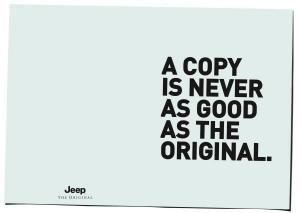 There are many best practice guides out there for creating your PPC text ads, so here we will go beyond best practices and cover important lessons that are used in any form of copy writing.
There are many best practice guides out there for creating your PPC text ads, so here we will go beyond best practices and cover important lessons that are used in any form of copy writing.
The lesson’s are broken down to Do’s and Don’ts to make it easier to digest.
Do’s of Copy Writing for PPC Text Ads
Do Include a Call to Action
Simply put, the call to action points the potential customer towards the next step in the sales funnel. For example an obvious call to action for E-commerce Advert would be “Buy Now”. But I would argue that it’s much more useful to create a call to action that is customized to your customer’s typical shopping cycle.
For example if you are advertising cars online, the ultimate goal is for the customers to buy the car, but the next step is most likely to browse the car’s image gallery or watch the short review video on the landing page. So in this case the call to action maybe “Watch our Review Video Now”.
The key take away is to look at the usual steps your existing customers take during their purchase and point them to the next step using your ad (depending on where the audience is in the purchase cycle).
Do write about the Benefits

Think about the Benefits of this Sport Cars, not its features
The best way to connect with the target segment is to tell them the product benefits. The key here is to give them the benefits not just the features. Using a sport car example, the 7 speed transmition, 425 horse power motor and “ultra sport” suspension are all the features of the this BMW. The features are all focused around the product not the customer.
But Benefits are what the customer will get out of the product. For example they will enjoy: Safer passing on 2-lane roads or never a dull errand. By using benefits in your ads, you have already done most of the thinking for the customer and reading the copy immediately speaks to them.
They don’t have to figure out how the 450 horse power engine is good for them, they will instead imagine how fun it will be to pass those slow RVs on their next road trip. If you use benefits in your copy you are already several steps ahead of the competition. It’s a little challenging to think in benefits but it’s well worth the effort.
Do give your Ads Consistency
In any form of advertising, it’s beneficial to create a consistency among the individual ads. This is often known as the theme.
For example if you have ever ate at a Ruby’s Diner you may have noticed the nostalgic theme. At Ruby’s, the dining table, uniforms and even the coca cola posters on the wall are all from the 50s era. This same theme in their restaurant is used in every advertising campaign and embedded within their brand.

Ruby’s Diner 50s Classic Diner theme
There are several functions the theme serves for the customers: it gives the benefits, it helps differentiating the product, and arguably the most important thing it does is communicate loads of information within a fraction of a second.
This same principle holds true for creating text ads on AdWords. By keeping part of your copy consistent among all of your ads, the searchers will see the pattern no matter which keywords they are searching.
For example if they are searching for running shoes and using different branded terms, in just a few searches they will notice your ads and brand much faster than the competition. The human brain is the world’s best pattern recognition machine and that’s why advertisers often capitalize with consistency in their ads.
Don’ts of Copy Writing for PPC Text Ads
Now that we covered what we should do when writing text ads, let’s go over what to stay away from.
Do not direcly copy your competition
One of the reasons that it’s a bad idea to copy your competition comes down to fundamentals of marketing. Many of us have heard this word enough times: “Differentiation.” But let’s do a quick recap.
What differentiation means is that unless we show in in our advertising how we are different than the competition, and then the consumers will not be able to tell the difference.
Your offer might be very different and better indeed, but most consumers are being bombarded with thousands of advertising messages per day and depending on the type of product they are not motivated enough to dig deeper in their search and learn more about your product. We have to make it so easy to see how we are different that even a child will get it right away.

Differentiation may sound like a simple concept but it’s often times overlooked. For example, many new to AdWords may “barrow” the competitor’s copy, thinking it must be good if the competitor has been using it for a while.
This sort of practice is the exact opposite of Differentiation. Yes, it’s important to scout out the competitors ads, however for a different reason. You do it to see what their point of differentiation is and to make sure yours is not the same.
Another reason is that it can be much easier to look at a few competitors’ ad copy and just take your favorite parts. All of this lacks one the most important 3Cs in marketing, our own company. The main take away here is your competitor’s advantages are not necessarily yours, so do your homework and find out where you stand out before writing your ad text.
Do not add features or benefits that you do not offer
It might seem like a legitimate way to grab the searchers attention and get higher CTR (click thru rate), but advertising features or benefits you don’t absolutely offer will create unwanted expectations. And one of the most important parts of customer satisfaction is setting the right expectation from the start, even leaving a little room to impress them.
For example one our clients in the furniture industry often sees their competition advertise “Free Returns” in their adverts. After we took a closer look at the competitor’s site, we found that “Free Returns” really meant not charging a restocking fee.
This is obviously creating the wrong impression and may lead to distrust and negative word of mouth. A good rule of thumb is to imagine talking with your customer in person and being able to explain your advertising copy without turning red.
Do not add Capitalize Display URL
This is a pet peeve that I developed over time, so it’s ultimately up to you when deciding the formatting of the display URL. The reason I often do not capitalize display urls is because of how unnatural they look in the search engine result pages (SERPS).
This is especially true if your ads are showing in the top positions. Most searchers are not aware that the top positions are paid ads, and one way to make your ad even more “organic looking” is to use an all lower case display URL. Ultimately it’s advised to run an A/B test to see which version is performing better.
Do not add technical Jargon
In many industries the seller of the product is much more knowledgeable than their consumers. This combined with the fact that one person in a smaller company often handles multiple jobs means that a single person is handling the technical side and writing ad copy.
This may lead to ads filled with technical jargon that the less informed consumers will not understand. Since the seller and the consumer often come from different fields of experience, it is highly recommended to get feedback on your ad copy from other less technical people in your company to make sure they can easily understand the copy.
You’ll be surprised how many great incites you get when you ask others to look at your ad copy.They will often find something you overlooked, specially if they were not deeply involved in the process as you were.
